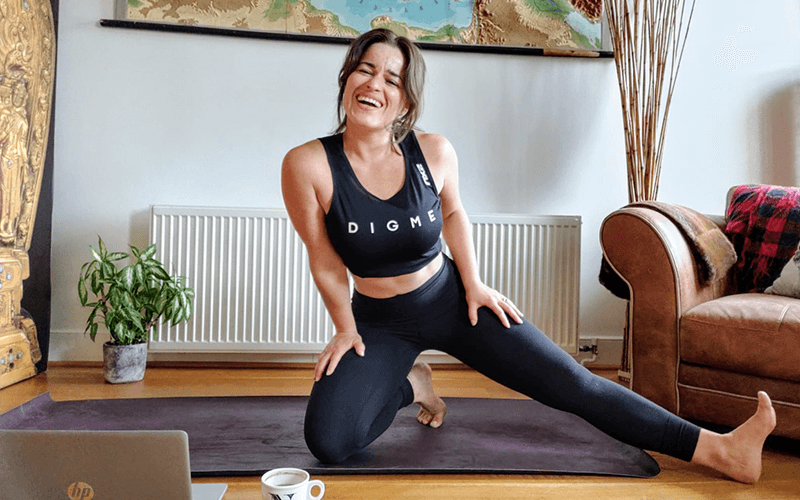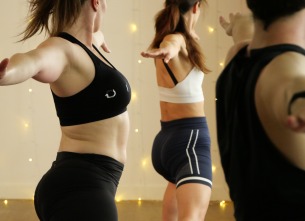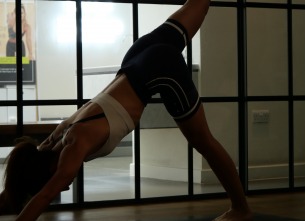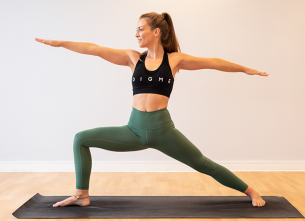Have you joined Tash's Yin practice yet? If not, you're missing out on the perfect Sunday night ritual to set you up for the week ahead. We caught up with Tash to find out everything we need to know about Yin and what to expect in her classes.
My name is Natasha (Tash), I’m a yoga teacher with Digme and while I greatly enjoy practicing and teaching all types of yoga, working up a sweat in a HIIT class or riding along in Cycle, I absolutely love teaching Yin.
So much of our physical wellness philosophy is represented by movement, energy, sweat, heart-rate and strength!
And while this is absolutely necessary - not to mention fun and satisfying - it’s easy to neglect the other side of the coin. The balance for our action-based, or Yang, regimen isn’t lethargy or a Netflix marathon. Rather, there is a deeper connection to be made with oneself and a conscious rest to be discovered, with Yin.
Yin is yielding; it is allowing; it is grounding. Yin is earth. Yin is bone. Yin is quietude.
Yin is simple - but it is not easy.
In Yin, we use the pose to get into the body, rather than manipulating the body to achieve a pose. It’s performance-free; it’s personal. It’s about feeling rather than executing. This is also why it’s best to practice Yin when the body is cold - as in, not warmed-up from Yang-type activity - so that we may practice with the body in its natural state with all the ligaments, fascia, joints and bones in mind; rather than bypassing them and experiencing only muscle tissue stretching.
In Yin, we use 3 principles, or tattvas, to help us guide ourselves through our practice:
1. Find your edge
When you come into a pose, only go to the point where you begin to feel sensation or resistance in the body. This may mean the pose does not look familiar. It may be a very subtle or non-specific shape. Habit may encourage you to go as deeply as you can to find a ‘juicy’ stretch right away. Instead, give your body the chance to open up and invite you to go deeper. After a time, the body may release and a greater depth may be possible - finding a new edge - but not always. Listen to the body and respect its requests.
2. Resolve to be still.
Once we have found our edge, we settle into the pose. We let go of our effort, sink into our skeleton and give in to gravity. We may need various props like cushions, blocks or blankets to support ourselves. Then we commit to stillness. We wait, without moving. Stillness means the muscles are inactive. The breath becomes quiet, effortless and gentle. To still the mind, the breath must be calm; to calm the breath, the body must be still. When these conditions are met, deep awareness is possible.
3. Hold for a time.
When we have found our edge and we have become still, all we have to do is stay there. In Yin we hold poses anywhere from two to five minutes - but sometimes even longer. The body tissues we are targeting in Yin do not respond well to constant movement. The benefit is in the hold, the release. This is why it’s so important to enter these poses mindfully and increase your depth gradually... you’re gonna be here awhile!
Now, you may be thinking: “Ok Tash, but what’s all this for?”
Yin yoga is an introspective and compassionate practice. We’re making time for conscious rest which engages the Parasympathetic Nervous System (PNS). Engaging the PNS helps to lower the heart rate and blood pressure, helps to stimulate the immune system and keeps the endocrine system operating healthily. It also offers us a greater sense of awareness and objectivity.
In Yin, we’re working with connective tissues like fascia, which tends to get stiffer and more immobile with age. These tissues need a different quality of movement than muscles. Turning the muscles off assists in the stretch or compression of these tissues. Yin yoga is also therapeutic for genetic asymmetries, repetitive patterns and/or emotional traumas held in the body.
Most poses in this practice target the lower body and their meridians - energy channels that flow along the body. Stimulating these meridians can have physical, organic and anatomical effects. They’re the same tributaries used by acupuncturists. You’ll find a lot of Yin classes are sequenced with these meridians in mind, seeking to not only offer physical relief but also an internal and mental homeostasis... and we do all of that in 60 minutes!
Like all things, it’s in the practice. When you come to your Yin practice time and again and explore the art of letting go you'll begin to notice the fluctuations in your body and mind as they arise. You'll feel many things throughout; discomfort, boredom, anxiety. As you learn to stay with those thoughts and feelings, your relationship to them will change. You may find you have an inner strength you never knew before, a new-found comfort with yourself, or a greater appreciation for the impermanent nature of things.
You can find me on the Digme at Home timetable at 6pm every Sunday. So grab some cushions, turn down the lights and come see what all the chill is about! Book now






COMMENTS (0)
Be the first to comment!
Please login to comment